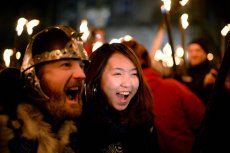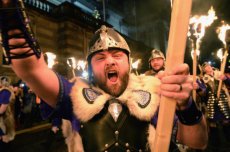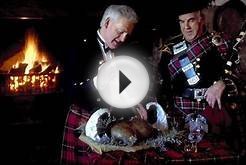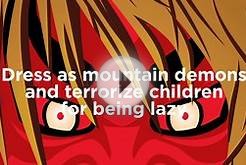 Edinburgh’s Hogmanay celebrations begin with a massive torchlight parade. (Picture: Jeff J Mitchell / Getty Images)
Edinburgh’s Hogmanay celebrations begin with a massive torchlight parade. (Picture: Jeff J Mitchell / Getty Images)
For most of the world December 31 is New Year’s Eve, but in Scotland it’s something much more important: Hogmanay.
So what is it, and why does it make Aberdonians set fire to stuff?
Hogmanay is a very big deal in Scotland. It’s the biggest day in the festive calendar, a celebration that makes Christmas Day seem very small indeed – and it’s like nothing else on Earth.
What is Hogmanay?
Hogmanay is what the Scots call their New Year’s Eve celebrations. The origins of the word are unclear – some say it’s a corruption of the Greek words for ‘holy month’, others that it’s of French origin – but the celebrations themselves go back centuries.
Where did Hogmanay come from?
Hogmanay’s origins are viking. Norse invaders celebrated the winter solstice, the shortest day of the year, with wild parties in late December.
 Those parties began to incorporate elements from the Gaelic Samhain winter festival, which celebrates the beginning of winter, and Yule, whose celebrations were known as ‘daft days’ in Scotland.
Those parties began to incorporate elements from the Gaelic Samhain winter festival, which celebrates the beginning of winter, and Yule, whose celebrations were known as ‘daft days’ in Scotland.
Like many annual celebrations, the end result is a mix of its various influences.
(Picture: Jeff J Mitchell/Getty Images)Why is it such a big deal?
Because until very recently, Scots didn’t do Christmas. The party-loving Protestant Reformation effectively banned Christmas for 400 years, and Christmas Day didn’t even become a public holiday in Scotland until 1958 and Boxing Day didn’t become a holiday until 1974.
So while the rest of the world celebrated Christmas, Scots toiled. Their family get-togethers happened at Hogmanay instead.
How is it different from other New Year’s Eve celebrations?
 It’s longer. Hogmanay starts on New Year’s Eve but continues throughout New Year’s Day and into January 2, which is a public holiday in Scotland.
It’s longer. Hogmanay starts on New Year’s Eve but continues throughout New Year’s Day and into January 2, which is a public holiday in Scotland.
While the rest of the UK is generally getting back to work on the 2nd, Scotland looks like that bit at the beginning of 28 Days Later when the streets are deserted.
How do Scots celebrate Hogmanay?
Most Scots party, but they also observe a number of traditions.
The most popular one is first-footing, where the first person to enter the house after midnight – ideally a tall, dark man – brings gifts such as food or coal. First-footing is supposed to affect the household’s fortunes for the coming year, so if your first visitor is a small blonde woman you’re stuffed.
Other traditions include cleaning the house before Hogmanay arrives, watching terrible TV programmes before the bells chime and singing Robert Burns’ poem, Auld Lang Syne.
That singing is accompanied by a mass linking of arms, and those arms are supposed to then cross each singer’s chest for the final verse. While most people know the first verse, the lusty singing tends to tail off in the second as people realise they don’t know most of the words.
Hogmanay in Edinburgh (Picture: Chris Watt)What about big events?
Edinburgh’s Hogmanay is the biggie: it starts with a massive torchlit parade on the December 30, includes a huge fireworks display, has performances from musicians ranging from up-and-coming acts to pop stars and the odd superannuated rock group, and pulls a crowd from more than 60 different countries.
Other Scottish cities have big parties too, but Edinburgh’s one is the biggest. In 1996, it attracted more than 400, 000 people, although subsequent years have been restricted to smaller (but still big) crowds for safety reasons.
Late December in Scotland. Isn’t that a terrible time to have an outdoor party?
Yes. Severe weather stopped the parties in 2003 and 2006.
This year’s forecast looks positively balmy by Hogmanay standards, though: it’s going to rain, but the rain shouldn’t be too cold.
Are there any weird traditions around Hogmanay?
In Stonehaven near Aberdeen the locals make balls of chicken wire, paper and rags, set them on fire and swing them around.







